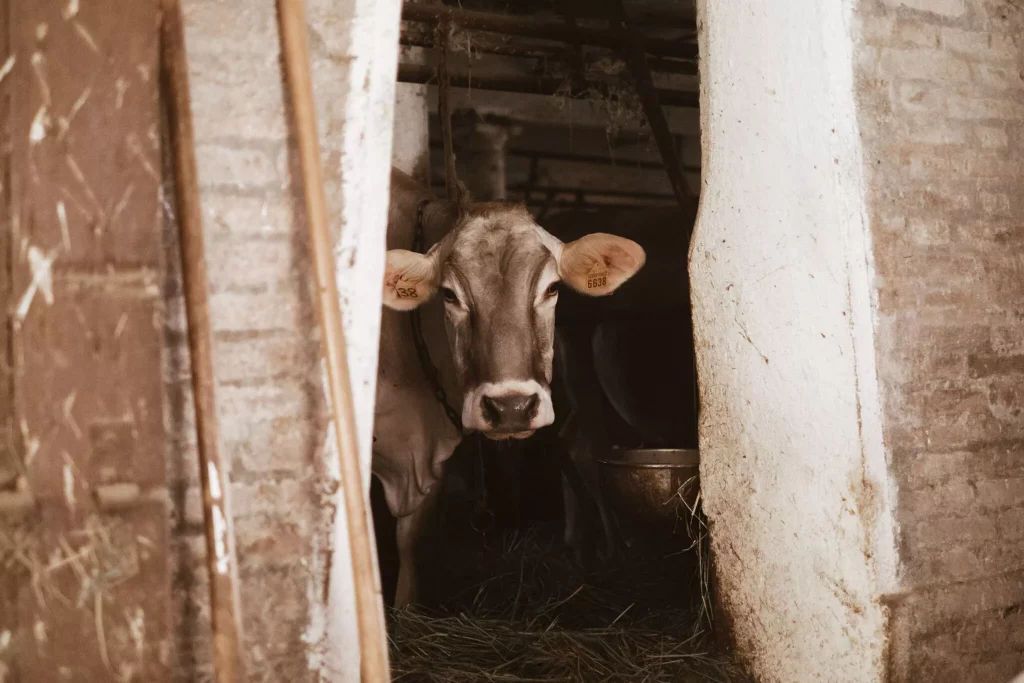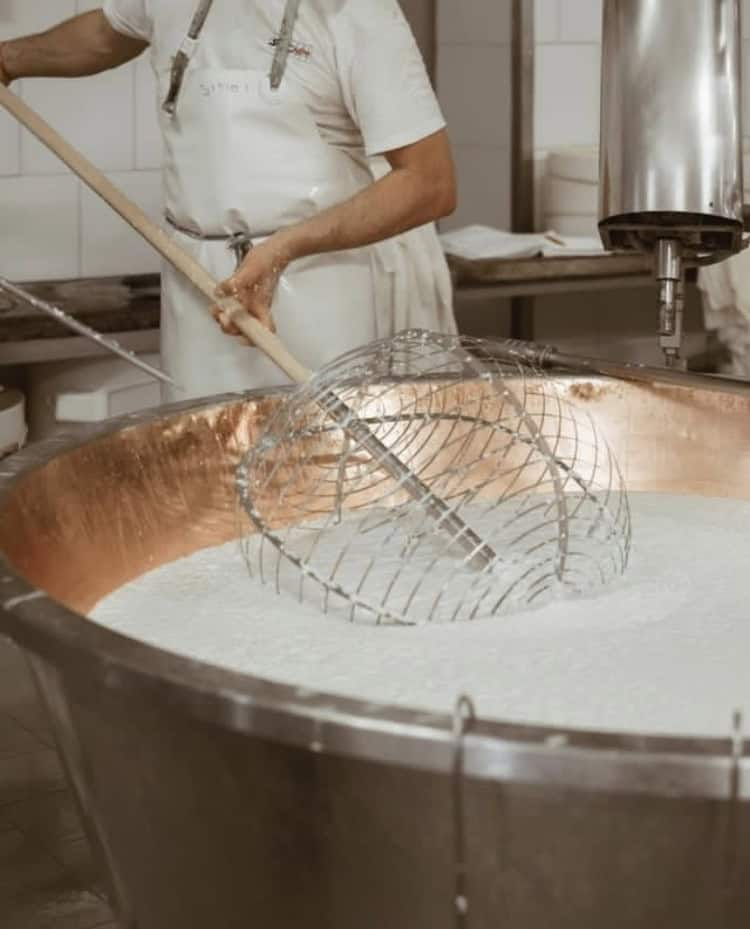“After a lovely tour, tasting and watching the brilliant bright Italian sun set from her shop, as we left – [Marisa] looked at me sternly and said ‘I wait you’– meaning she would wait for me to return to her dairy and talk about working together.”
Carrie Blakeman—Managing Director of Rogers Collection–is describing her first meeting with Marisa Verzelloni–master casara, or cheesemaker of Parmigiano-Reggiano of Caseificio di Gavasseto e Roncadella in the eponymous villages within a few kilometers of each other in the Emilia Romagna province of Italy. (At the time of their first meeting, the two villages – Gavasseto and Roncadella – had separate dairies and Marisa was casara of Caseificio Roncadella). It was May, 2015 and Carrie was in Parma for the Cibus International Food Exhibition–a fair for the Italian agri-food sector.
“I had been at the fair all day,” says Carrie. “I got a call from a colleague who lives in Italy who said, ‘I’m coming to pick you up, there is someone you should meet.’” That was, of course, Marisa. “Marisa and I had an instant connection,” Carrie says. She adds with a tone of humility, only to highlight their connection, “Until our meeting, [Marisa] never once considered selling her cheese to the USA. I could not wait to get back there.”
**************************************
 In 1925, the neighboring towns of Gavasseto and Roncadella each had their own separate dairies with family-run farms from the two villages. The two dairies each had latteria sociale–literally translated to “social dairy” which refers to the farmer-owned cooperative nature of the two dairies. The goal of the latteria was to build factories, scale up production of Parmigiano Reggiano and adopt new technologies– a “we are stronger together” philosophy that has carried over into the joint co-operative to this day.
In 1925, the neighboring towns of Gavasseto and Roncadella each had their own separate dairies with family-run farms from the two villages. The two dairies each had latteria sociale–literally translated to “social dairy” which refers to the farmer-owned cooperative nature of the two dairies. The goal of the latteria was to build factories, scale up production of Parmigiano Reggiano and adopt new technologies– a “we are stronger together” philosophy that has carried over into the joint co-operative to this day.
Now–100 years later– the towns have merged their production, making one co-operative dairy called Caseificio di Gavasseto e Roncadella and giving farmers the option to join the merger or independently sell their milk to other sources.
Paolo Crotti–born in the town of Roncadella nearly 50 years ago and now managing director and lead board member of Gavasseto and Roncadella–says, “New challenges arise–sustainability, digitalization, environment– [and] that’s why Caseificio di Gavasseto e Roncadella was created: to prepare for the future, keeping the same artisanal touch that makes our Parmigiano Reggiano exceptional.” After the merger, the co-op is still considered small even though there is an increase in both the number of farmers and production of cheese.
This decision was monumental because both dairies were run by important cheesemakers who, in theory, were in competition with one another. Usually aging cheesemakers just end their projects. But not Gavasseto or Roncadella: the management at the dairies got together to decide how to continue on as their cheesemakers aged. This gave the farmers the opportunity to stay with a small co-op or just sell their milk on the large market.
“[It is] to preserve this ecosystem of small family run businesses compared to economy of scale that many other caseifici are applying,” Paolo says. He knows first-hand about small family farms. “My family farm Podere Giardino produces milk and we are a member of the co-op of Gavasseto and Roncadella. We have three breeds: Italian Frisona, Red Swedish, and French Montbelliarde. In general, Gavasseto e Roncadella you can find mostly Italian Frisona with a few Italian Red Cows, Simmenthal and Alpine Brown.”
 “We at Gavasseto e Roncadella feed our cows with fresh grass during the spring and summer seasons,” Paolo says. “Something not common anymore despite many claiming it…..we have [17] small family-run farms and geographical contiguity.” The benefit of the contiguity Paolo refers to is the fact that the majority of the 17 farms are within 2 kilometers of each other in the villages of Gavasseto and Roncadella, with a few 5 to 6 kilometers away. The welfare, diet and proximity of the animals to the dairy makes for a high-quality, fragrant and nutrient-rich milk.
“We at Gavasseto e Roncadella feed our cows with fresh grass during the spring and summer seasons,” Paolo says. “Something not common anymore despite many claiming it…..we have [17] small family-run farms and geographical contiguity.” The benefit of the contiguity Paolo refers to is the fact that the majority of the 17 farms are within 2 kilometers of each other in the villages of Gavasseto and Roncadella, with a few 5 to 6 kilometers away. The welfare, diet and proximity of the animals to the dairy makes for a high-quality, fragrant and nutrient-rich milk.
**************
Two years after Carrie first met Marisa, she had an opportunity to see her again. In Italy again in 2017, Carrie brought Ari Weinzweig and Grace Singleton of Zingerman’s Deli in Ann Arbor, Michigan to meet Marisa Verzelloni of Roncadella and taste their renowned Parmigiano-Reggiano. Due to delays and an early Sunday closing time, they arrived too late. The blinds were drawn and a “closed” sign hung on the door.
“I rolled down my window and I can hear talking in Italian,” Carrie says. Encouraged by the sound of activity, the three got out of the car and peered through the shop’s windows. Despite the blinds being shut, Marisa caught sight of them, opened the door and beckoned them inside with big hugs, saying, “Come in! Come in!”
*****************
There is another key component to crafting an exceptional Parmigiano-Reggiano. A good casara or casaro (cheesemaker) is the foundation of a caseificio. Cheesemakers work tirelessly, often without a day off for long stretches of time including Sundays and Christmas. Gavasseto e Roncadella is blessed with two master cheesemakers who have decades of combined experience. Marisa–mentioned earlier– and Silvano, who for years was the master cheesemaker of Roncadella’s neighboring co-op, Gavasseto. “Their experience and mutual respect permit us to be at the top of our sector [for] production and quality,” Paolo says.
Marisa began as a reluctant cheesemaker. But her experience began well before that in 1976, when her husband was the cheesemaker for Roncadella. She worked with him, learning this highly-skilled and difficult art— but not with the intention of becoming a cheesemaker herself. At that time–and even today–it is unusual for a woman to be a casara. When Marisa’s husband died at a fairly young age, the Management Board asked Marisa to become lead casara. She resisted, feeling that–despite her years of experience alongside her husband–she was not qualified. But the co-op board persisted, and their faith in her won her over.
 Paolo says Marisa knows all the people very well who come to their retail cheese shop. He describes her as a “behavioral psychologist,” knowing the details, preferences and personalities of the locals who come to her shop again and again, and connects with people. “My working relationship with her is almost like me and my mum,” Paolo says. “Every day we speak about domestic market trends, consumer preferences .. and, obviously, we exchange comparisons about the best way to satisfy them.”
Paolo says Marisa knows all the people very well who come to their retail cheese shop. He describes her as a “behavioral psychologist,” knowing the details, preferences and personalities of the locals who come to her shop again and again, and connects with people. “My working relationship with her is almost like me and my mum,” Paolo says. “Every day we speak about domestic market trends, consumer preferences .. and, obviously, we exchange comparisons about the best way to satisfy them.”
“She is still the pivot of our dairy, with Silvano,” Paolo says. Silvano–who is about the same age as Marisa–hit the 30 year mark as casaro alongside Marisa. “He has been instrumental in preserving a tradition that now we…value even more. It is not easy to resist the sirens of modernization,” Paolo says.
Perhaps Silvano’s approach to cheesemaking is best described in Paolo’s words: “ He employs technology in the production of Parmigiano Reggiano but ‘with a pinch of salt’ because he believes in giving the cheesemaker the ability to read and interpret the milk while cooking it.” Rather than mixing the milk from the various farms, he chooses to keep the cows’ milks separate based on his knowledge of the flavors and qualities of each individual farm’s milk and decide later how to mix the milks. Although the cheesemaking process is partially intuitive with Marisa testing the temperature of the milk on her arm and Silvano’s “pinch of salt” approach, they use technological aspects as well.
And to put the astounding results into numbers: they have been able to obtain a 96% approval rate for cheese officially recognized as Parmigiano Reggiano and upheld by the quality standards of the Consorzio at the age of 12 months. [compared to the average of 88-90% for all other caseifici producing Parmigiano Reggiano.]
Both Marisa and Silvano have earned several awards including “Cheesemaker of the Year” from the “Consorzio” for their result and performance this last year. “I consider that our best aging is almost 26-27 months,” says Paolo. “It has a cream-yellow color with aromas of melted butter and rind…and sometimes nutmeg. It tastes of nuts with [crunchy and flavorful] tyrosine crystals…a perfect balance between sweet and savory.” Rogers Collection has chosen to import the 24-month wheels. We believe this is the best expression that encapsulates the blend of cheesemaking between Silvano and Marisa.
Each co-operative or farm that makes official Parmigiano Reggiano in Italy gets a designated farm number from the Consorzio. And every time a wheel of cheese is made and approved in their fashion, the Consorzio will hand-stamp this number onto the wheel. Prior to the merge, Roncadella’s farm number was 115 and Gavasetto’s farm number was 168. Now, they are moving forward keeping the number 168; all wheels of cheese stamped by the Consorzio coming from Gavasseto e Roncadella will use this number.
 “Our great-grandfathers founded [the dairies],” says Paolo, “and our mission is developing a company that isn’t made of bricks, but of tradition, territory, people, families, nature.” He adds, “Our philosophy hasn’t changed…. small and controlled production and land and animal welfare. Our consumer is increasingly careful..regarding sustainability, [respecting] nature and local production. On this path, we define our future.”
“Our great-grandfathers founded [the dairies],” says Paolo, “and our mission is developing a company that isn’t made of bricks, but of tradition, territory, people, families, nature.” He adds, “Our philosophy hasn’t changed…. small and controlled production and land and animal welfare. Our consumer is increasingly careful..regarding sustainability, [respecting] nature and local production. On this path, we define our future.”
Rogers Collection is grateful for that initial connection with Marisa over seven years ago and the resulting relationship between Caseificio di Gavasseto e Roncadella and Rogers Collection. Rogers Collection has been importing from Roncadella from 2017 through the present. And now the first wheels from the merger between the Gavasseto and Roncadella dairies have arrived! At the 2022 New York Summer Fancy Food Show, Federico Bolla of the Parmigiano-Reggiano Consorzio cracked the first wheel of 24-month Gavasseto and Roncadella to enter the USA. This event was attended and assisted by Susan Axelrod, editor of Culture Cheese Magazine.
We’re thrilled to celebrate this monumentous merger of Marisa and Silvano’s cheesemaking and to continue to represent their artisanal approach to cheesemaking.
Written by Leska Tomash